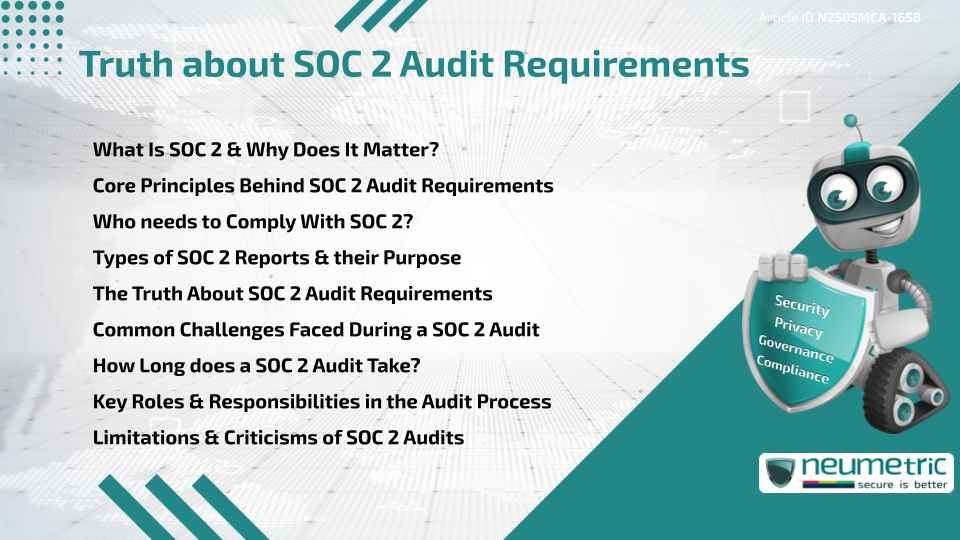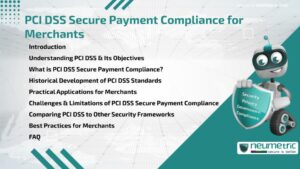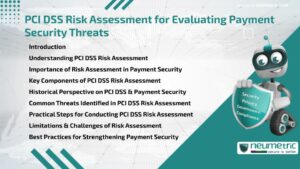Table of Contents
ToggleIntroduction
Many technology companies today are asked to prove their commitment to security & trust. One of the most recognized ways to do this is through a SOC 2 Audit. But what’s the real story behind these requirements? Are they as complicated as they seem or are they misunderstood? In this article, we unpack the truth about SOC 2 Audit requirements, making it easier for businesses to understand what’s really involved.
What Is SOC 2 & Why Does It Matter?
SOC 2 stands for System & Organisation Controls 2, a Framework developed by the American Institute of Certified Public Accountants [AICPA]. It focuses on non-Financial reporting controls related to security, availability, processing integrity, confidentiality & Privacy.
Unlike a certification, SOC 2 is an Audit-based attestation. That means an independent auditor reviews your controls & issues a report. It’s particularly vital for Software as a Service [SaaS] companies, cloud service providers & vendors who handle Customer Data.
Core Principles Behind SOC 2 Audit Requirements
The truth about SOC 2 Audit requirements revolves around its five Trust Service Criteria:
- Security: Is your system protected from unauthorized access?
- Availability: Is your system available for operation as agreed?
- Processing Integrity: Is your system processing data accurately & completely?
- Confidentiality: Is Sensitive Data protected appropriately?
- Privacy: Are you handling Personal Information according to your stated Policies?
Not every company is required to cover all five. Most focus on security & build from there, based on business needs & Customer expectations.
Who needs to Comply With SOC 2?
The truth about SOC 2 Audit requirements is not that it’s mandatory by law, but rather it’s a Standard driven by market demand. If your clients—especially enterprises—ask for a SOC 2 Report, you’ll likely need to comply.
This applies especially to:
- SaaS vendors
- Cloud storage providers
- Managed service providers
- Data analytics firms
Having a SOC 2 Report can offer a competitive edge & build Client confidence.
Types of SOC 2 Reports & their Purpose
SOC 2 has two main types:
- Type I: Reviews the design of controls at a specific point in time.
- Type II: Assesses the operational effectiveness of those controls over a minimum of three (3) months, often six (6) to twelve (12).
Type II is more comprehensive & widely requested by larger clients.
The Truth About SOC 2 Audit Requirements
What’s often overlooked in the truth about SOC 2 Audit requirements is that the process is highly customizable. Unlike ISO standards that are more prescriptive, SOC 2 allows companies to define their controls—as long as they meet the criteria.
However, this flexibility can also create confusion. Companies may over-engineer solutions or miss gaps in their current controls. The Audit doesn’t demand perfection, but it does require documented proof of Policies, procedures & evidence of enforcement.
Common Challenges Faced During a SOC 2 Audit
Even with best intentions, Organisations face hurdles:
- Lack of clear documentation
- Inconsistent Access Control Policies
- Poor Evidence Collection
- Misunderstanding scope & responsibilities
The truth about SOC 2 Audit requirements is that the Audit is not just about tools—it’s about people & processes working together. Many fail their first Audit due to poor internal communication, not technical failure.
How Long does a SOC 2 Audit Take?
A SOC 2 Type I Audit can take one (1) to two (2) months. A Type II Audit typically takes four (4) to six (6) months, including monitoring.
It depends on:
- Current readiness
- Team availability
- Scope of Trust Service Criteria
- Existing documentation
A readiness assessment is often recommended to streamline the process.
Key Roles & Responsibilities in the Audit Process
To ensure a smooth Audit:
- Executives should set clear goals & approve budgets.
- IT & Security Teams should implement & maintain controls.
- Compliance Officers should oversee documentation & Audit readiness.
- External Auditors should provide guidance & issue the final report.
Misalignment among these groups is a leading cause of Audit failure.
Limitations & Criticisms of SOC 2 Audits
No Framework is flawless. The truth about SOC 2 Audit requirements includes these limitations:
- Subjectivity: Different auditors may interpret requirements differently.
- Snapshot-Based: A Type I report is only valid for one moment in time.
- Client Misunderstanding: Some clients treat the SOC 2 as an all-encompassing security badge, which it is not.
Despite these drawbacks, SOC 2 remains a valuable part of a trust-building strategy.
Takeaways
- SOC 2 is not a legal requirement but a widely adopted standard.
- The Audit is flexible but requires structured evidence.
- Many companies struggle with documentation, not technology.
- Type I & Type II reports serve different business needs.
- It’s not about perfection—it’s about consistency & intent.
FAQ
What makes SOC 2 different from other Compliance frameworks?
The truth about SOC 2 Audit requirements is that they’re based on trust principles rather than fixed controls, offering flexibility but also creating ambiguity.
Can Small Businesses handle SOC 2 audits internally?
Yes, but the truth about SOC 2 Audit requirements is that many smaller teams benefit from Third Party support to manage time & reduce Risk of failure.
Is a SOC 2 Type I report enough?
It depends on Client needs. The truth about SOC 2 Audit requirements is that Type I is often a starting point, but Type II builds deeper trust.
Do I need to meet all five Trust Service Criteria?
No. The truth about SOC 2 Audit requirements is that you can choose criteria relevant to your services, often starting with Security.
How often do I need to conduct a SOC 2 Audit?
Generally, once a year. The truth about SOC 2 Audit requirements includes the need for ongoing Compliance, not one-time checks.
Can I fail a SOC 2 Audit?
Technically, no. But the truth about SOC 2 Audit requirements is that your report may note exceptions, which could impact Client confidence.
Is the SOC 2 Report made public?
No. The truth about SOC 2 Audit requirements is that reports are private & shared only with clients under non-disclosure agreements.
What if I don’t have a security team?
You can still comply. The truth about SOC 2 Audit requirements allow for outsourcing security responsibilities, as long as controls are in place.
Need help?
Neumetric provides organisations the necessary help to achieve their Cybersecurity, Compliance, Governance, Privacy, Certifications & Pentesting goals.
Organisations & Businesses, specifically those which provide SaaS & AI Solutions, usually need a Cybersecurity Partner for meeting & maintaining the ongoing Security & Privacy needs & requirements of their Clients & Customers.
SOC 2, ISO 27001, ISO 42001, NIST, HIPAA, HECVAT, EU GDPR are some of the Frameworks that are served by Fusion – a centralised, automated, AI-enabled SaaS Solution created & managed by Neumetric.
Reach out to us!





